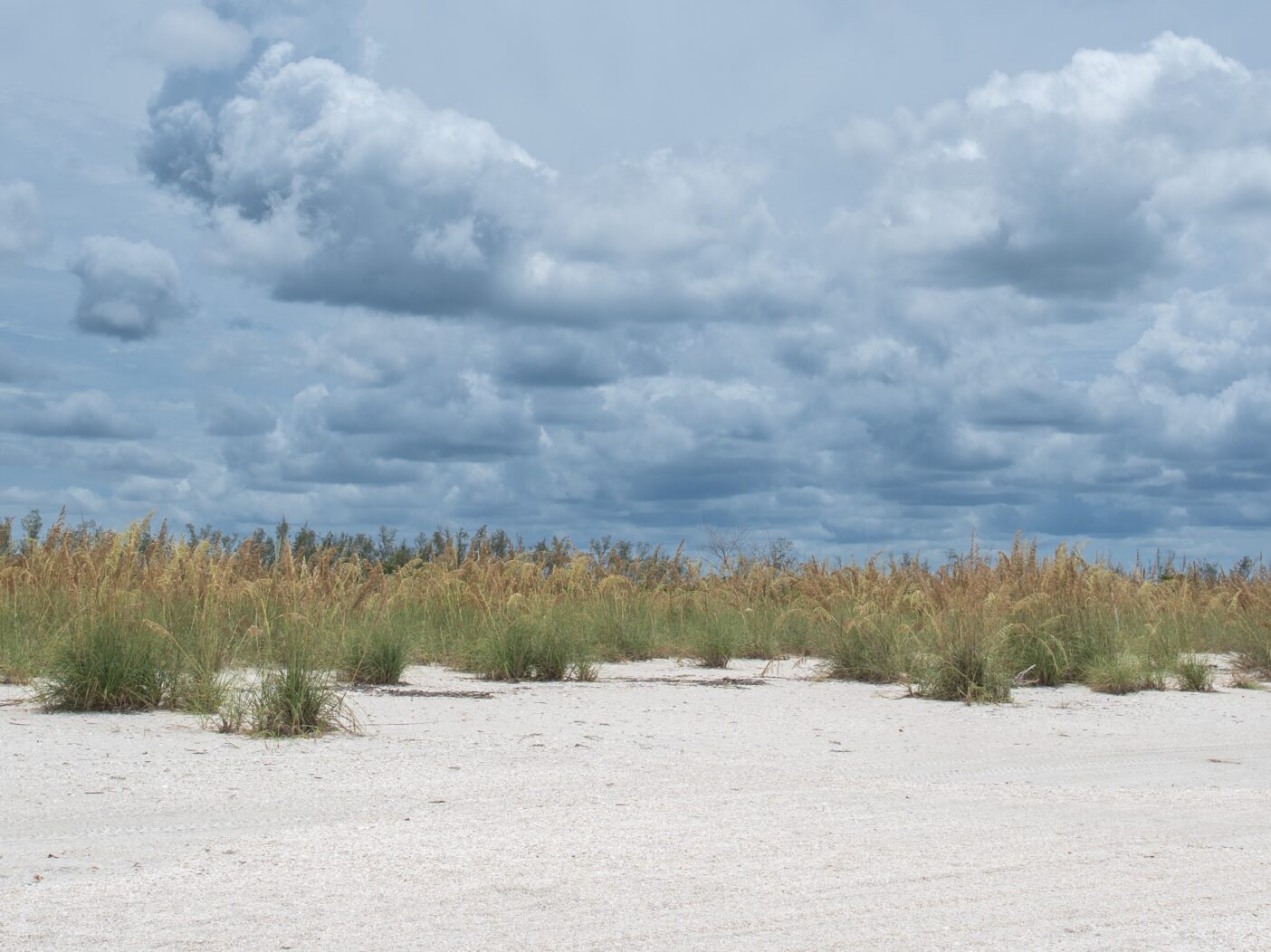
Naples Botanical Garden and Florida Gulf Coast University study the workings of beach dunes and develop a restoration formula.
The plant is a botanical jackpot. Vice President of Conservation Chad Washburn approaches a 7-foot-tall shrub on a Keewaydin Island beach.
“This is perfect,” he exclaims. “It’s covered in seed.”
The plant is wild Suriana maritima, or bay cedar, a coastal species that plays an important role in stabilizing beach dunes.
“I would say it’s arguably gorgeous,” Washburn continues. The foliage resembles succulent leaves, and the seeds are a pale green with blueberry-like crowns. When in bloom, the plant produces tiny yellow flowers. Washburn stations a staff member to gather ripe seeds.
The Garden, along with several Florida Gulf Coast University faculty, has undertaken a major beach dune research and restoration project to chronicle the plant species along our shoreline, understand the roles they play in the ecosystem, and develop a restoration strategy that replicates what’s found in nature. The intention is to create a natural line of defense against wind and water damage. The Garden began the research about five years ago and ramped it up following Hurricane Ian, inviting the university’s involvement and soliciting the support of the Collier Community Foundation, Second Chance Foundation, and individual donors to provide funding for some initial costs.
Beach dunes can’t fully prevent the destruction of storms like Ian, but the mounds of sand and plants can dissipate energy and blunt the blow. What’s more, a strategically planted beach dune can protect investments in beach renourishment and related projects, such as a berm in Collier County costing approximately $20 million and requiring an estimated 400,000 tons of sand. Plants limit the sand lost to erosion from wind and water.
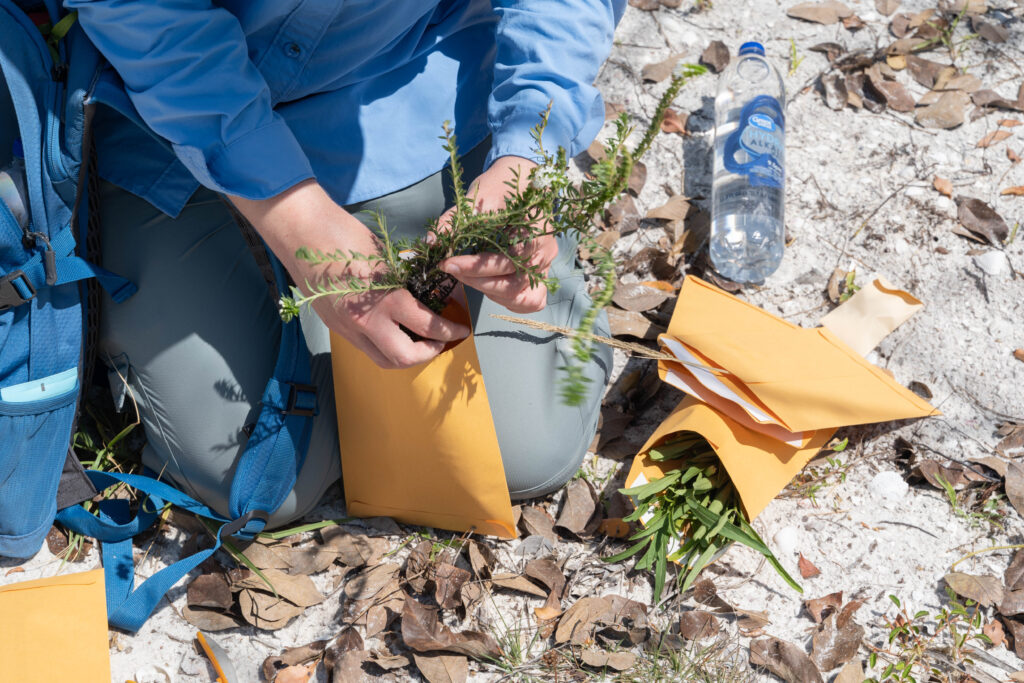
While the Garden favors nature-based solutions, Washburn doesn’t rule out human-made structures like berms and walls, if they are done in tandem with green projects.
“We need to look at every tool in the toolbox,” he says.
The dune restoration starts with gathering seeds and cuttings from area beachfronts. The team brings these back to the Garden with the intention of multiplying them by the thousands for future restoration plantings. There, in labs and nurseries, specialists work to determine the best growing methods. Most pre-existing coastal botanical research involves plants from other regions.
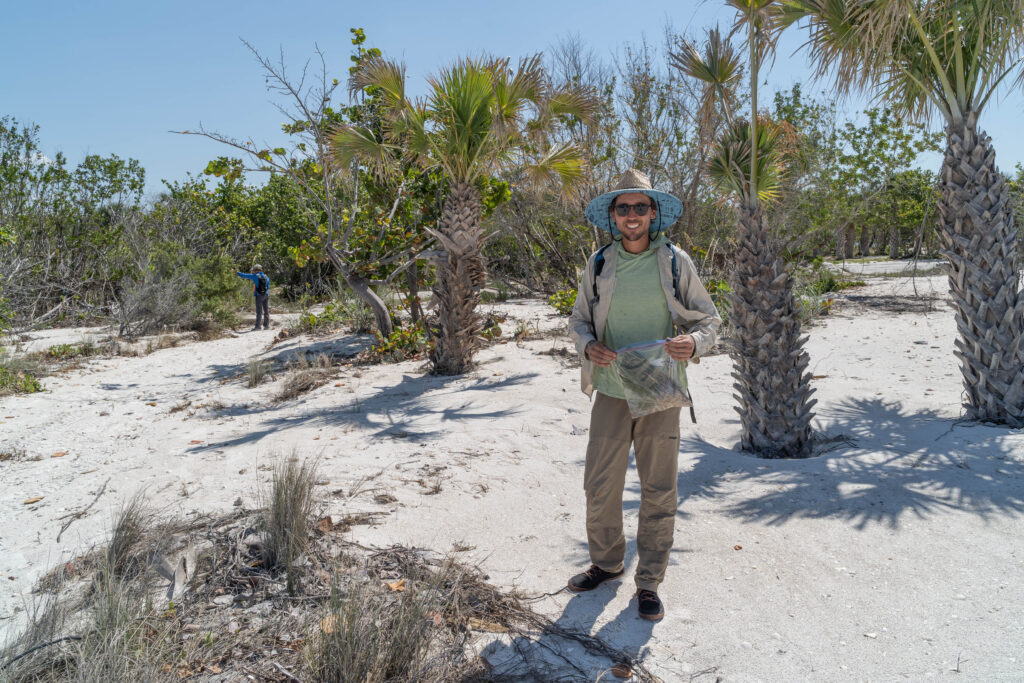
In fact, there are many unknowns about the beach ecosystems in Southwest Florida. That’s why this initiative began with long, slow walks on the beach, detailed observations, and questions that only plant people might ask.
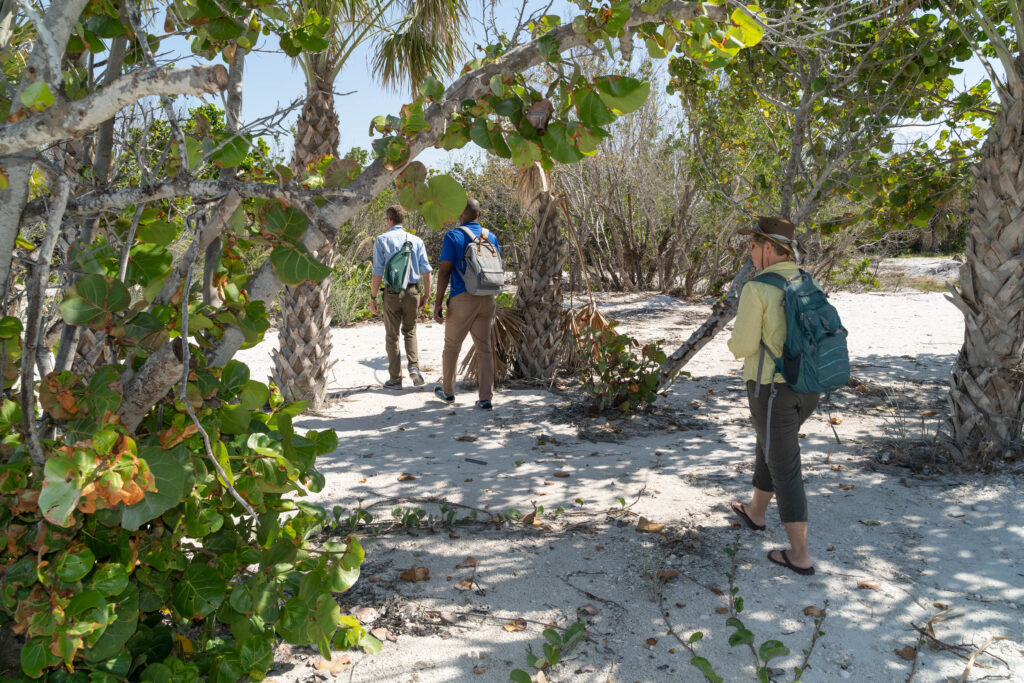
In early May, Delnor-Wiggins Pass State Park bears the feels-like-yesterday scars of Hurricane Ian even eight months later. The beach’s long closure, starting with Ian’s landfall in September 2022 and lasting through May 15, 2023, makes it an ideal, undisturbed research site.
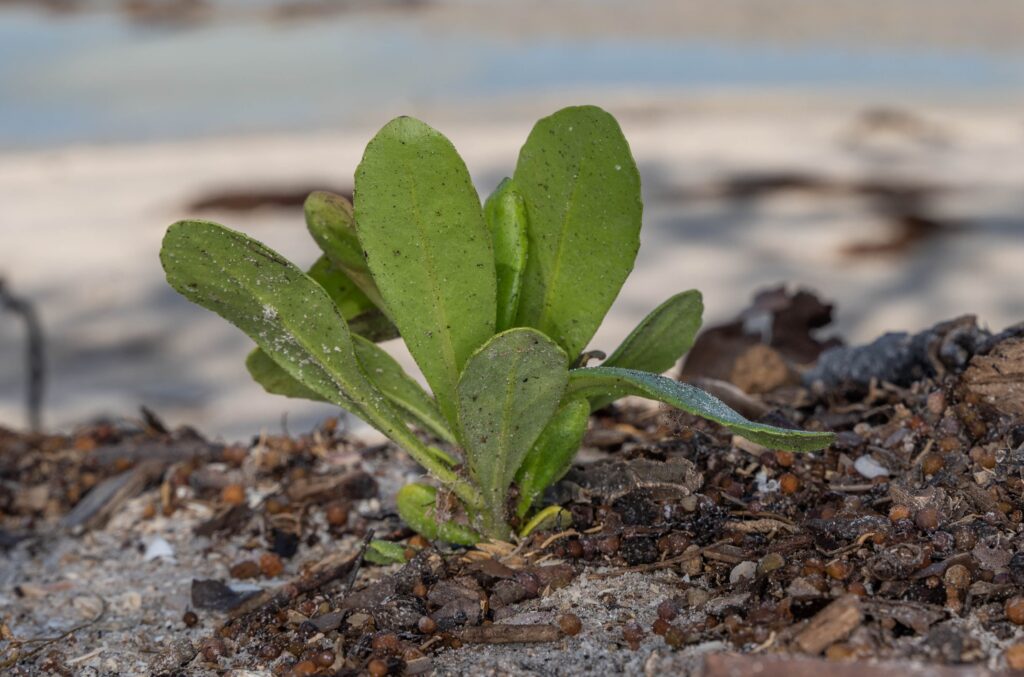
“Native Scaevola,” notes Washburn, pointing to the thick-leaved, low-growing Scaevola plumieri. “Those are the first two I’ve seen on the beach.” With him this morning are Jeannine Richards, FGCU Assistant Professor of Restoration Ecology, and Britt Patterson-Weber, the Garden’s Vice President of Education & Interpretation, who will develop public education programs about the importance of beach dunes and the Garden’s restoration work.
“And here is Iva imbricata. It’s our ‘rockstar plant,’” Washburn continues. On several excursions to various beaches, the team has noted how a “disturbance” such as a storm appears to invigorate this bushy shrub, commonly known as beach elder. It’s among the first to rebound and plays a big part in stabilizing dunes.
The team records which species re-emerge most quickly after a storm and jumpstart the natural rebuilding process. They investigate which plants invite the sprouting of other species and question why that is: Because they hold moisture? Provide shade? Catch seeds? They note the plants’ locations on the dunes and study the roles each species appears to perform.
“It’s really interesting to see how these different species are responding,” Richards says. “The Iva imbricata is doing wonderfully. The beach sunflower (Helianthus debilis) is coming back all over the place. Some things come back quickly. Some things that were present in abundance are no longer there or no longer abundant.”
She continues: “When we have a disaster, it basically wipes the slate clean. We need all of the skills of all of those different plants to come back and bring (the ecosystem) together again.” In short: Biodiversity matters.
Typical beach restoration practices usually don’t take that into account. Generally, coastal managers install one or two species along the dunes; sea oats (Uniola paniculata) are the most common.
“If you just have sea oats, you’re not going to have that ability to recover quickly from a storm,” Washburn says. New populations of the tall, grain-like grasses had started to sprout but not as swiftly or robustly as other species.
To emphasize his point, Washburn returns to one of the Garden’s beach dune pilot project sites. In spring 2021, the Garden partnered with the City of Naples and planted three access points along Naples Beach using a range of native plants. The patches the Garden planted had recovered to a greater degree than adjacent areas.
“This came back on its own,” Washburn says, pointing to an Iva imbricata. “And this dune mound here is because of this plant.”
Nearby, a cluster of beach sunflowers brightens the beach with yellow blooms. They are nearly buried in sand, and that’s a good thing. It means they’re holding onto granules from the existing beach and the county’s new berm.
Washburn proposes using about 15 species in the eventual dune replanting, tightly clustered and installed either at the fore dune (the side closest to the water), rear dune, or the dune’s crest, depending on plant type. In nature, Washburn explains, one might see multiple beach dune complexes. In much of Naples, waterfront development narrows the land available for dune formation.
“We have less area for a diversity of species, and that’s why it’s so important we rebuild with the right ones,” he says.
Biodiversity is not just for the sake of coastal resilience — a plethora of plant types provides habitat for coastal wildlife, including sea turtles, and food for critters and pollinators.
“Dunes are almost like a linear wildlife corridor,” Washburn says.
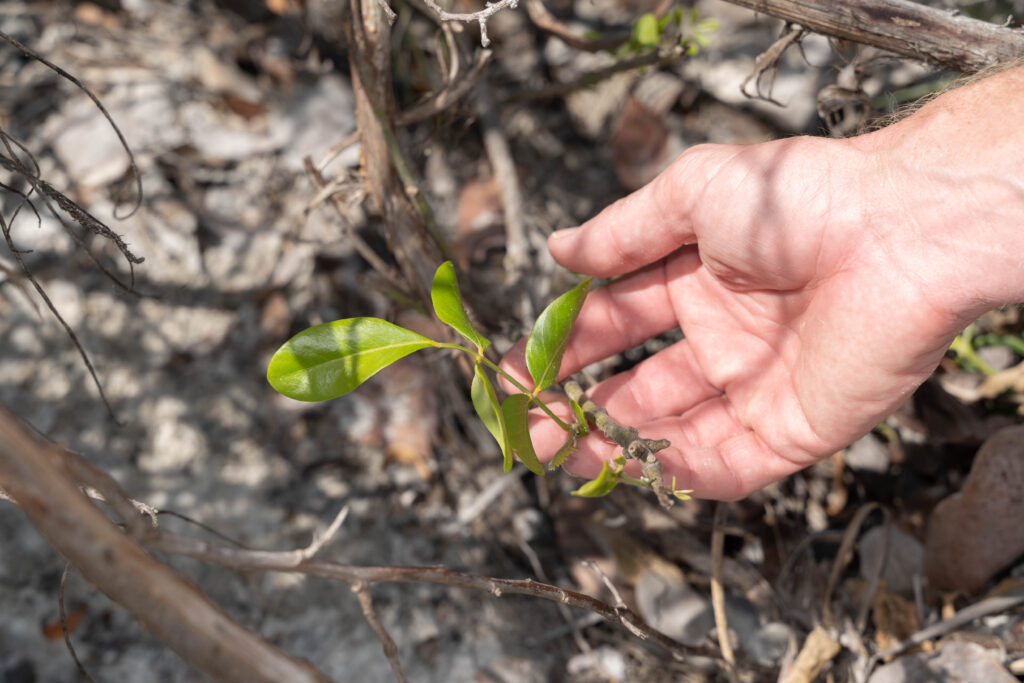
Once a collection trip ends, Conservation Horticulture Manager Jessica DeYoung and her team retreat to a potting shed for an all-hands-on-deck effort to process the newly gathered seeds and cuttings. They are experimenting with everything from seedling trays to growing media to determine the recipe for prompting these plants to sprout quickly and grow to maturity.
As of July, DeYoung tallied about 2,000 plants representing 21 species and more than 50 maternal lines collected from various beaches to ensure genetic diversity. Using homegrown plants from Southwest Florida genetics complicates the project (it would, naturally, be easier to order commercially grown nursery stock), but the conservationists say plants that are adapted specifically to our region are more likely to thrive and will better support the area’s pollinators and wildlife.
“I’m exceptionally excited about this,” DeYoung says. “This is putting the science into practice. I’m very happy we’re finally going to be able to take this step that we’ve been talking about for so long.”
A timeline for replanting is to be determined. Washburn is in close conversation with Collier County and the City of Naples, which manage the coast and ultimately will determine when and how the beaches are to be restored.
In 2022, Collier County saw 1.6 million visitors who contributed nearly $2.8 billion to the local economy. The coast — the beaches and the many establishments situated along them — drive tourism.
“Beach dunes are a vital part of our coastal community’s resiliency,” Washburn says. “They are the basis of our thriving tourism economy and provide a protective barrier against storms and hurricanes.”
This article originally appeared in the 2023 issue of Conserve, the Garden’s environmental publication.

About the Author
Jennifer Reed is the Garden’s Editorial Director and a longtime Southwest Florida journalist.


